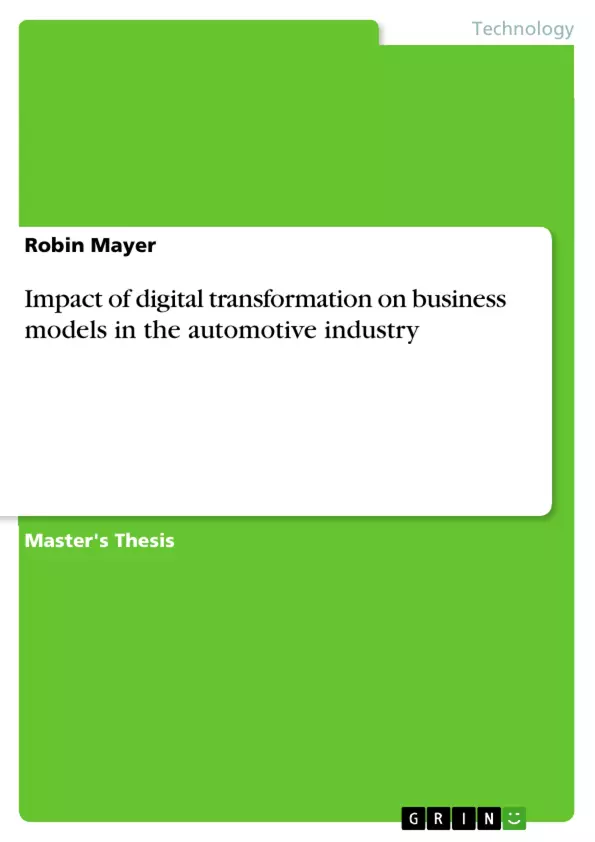Digital transformation and disruptive business models of new market players create unprecedented uncertainty in the automotive industry. One of the main reasons is the lack of understanding for the need of adapting business models to a changing business environment due to new technologies and shifting customer wants and needs. Even the automotive industry is not spared from digital Darwinism, according to which it is not the strongest or most intelligent of a species that survives, but rather the one that adapts best to change.
What opportunities do OEMs have to transform their business models? How can best practices be used to generate new value creation, and what influence does the transformation of the business model have on the ecosystem? What role will the dealer play in the future, and how can he still deliver added value to the OEM?
This paper provides an in-depth insight into the world of automotive sales, as well as a detailed analysis of the status quo. Best practices based on successful business model transformations of the top tier OEMs are the basis for a deeper understanding and serve other companies as foundation for developing digital business models.
The goal of this paper is to examine the impact of digital transformation on the dealer business model and how they can continue to deliver value to the OEM. For this purpose, guided expert interviews are conducted with 16 experts from various areas of the automotive industry. Subsequently, a qualitative content analysis according to Mayring will be used to assess the challenges and impacts of the agent business model and to develop improvement measures and key topics that offer added value for OEMs.
The results of this thesis support dealers in understanding their future role in the automotive industry and show design recommendations for a future-proof business model.
Inhaltsverzeichnis (Table of Contents)
- Abstract
- List of Abbreviation
- List of Figures
- List of Tables
- Introduction
- Subject of the Research
- Purpose of the Research
- Structure of the Research
- Literature Review
- Impact of Digital Transformation on the Business Model
- Business Models in the Automotive Industry
- Wholesale Model
- Direct Sales Model
- Agency Model
- What's about the Dealer?
- Best Practices
- Comparison of Business Model Approaches of successful OEMs
- Key Takeaways for the Transformation of Business Models
- Action Plan for the Implementation of an Agency Model
- Effects on the Ecosystem
- Method
- Research Methodology
- Quantitative Research
- Qualitative Research
- Quantitative vs. Qualitative Research
- Data Gathering
- Expert Interview
- Different Types of Interviews
- Guideline-based Expert Interview
- Qualitative Data Analysis
- Qualitative Content Analysis based on Mayring
- Quality Criteria of the Qualitative Content Analysis
- Research Methodology
- Findings
- Challenges of Agents in the Agency Model
- Limited Control over Pricing and Inventory
- Digital Transformation
- Change Management
- Impacts on the Agents' Business Model
- Customer
- Core Competencies
- Sales and After Sales
- Ecosystem
- Measures for Improvement
- Business Model
- Location
- Customer Experience
- Added Value for OEMs
- Customer Reach
- Customer Experience
- Local Market Knowledge
- Customer Relationship
- Challenges of Agents in the Agency Model
Zielsetzung und Themenschwerpunkte (Objectives and Key Themes)
This thesis investigates the impact of digital transformation on the dealer business model in the automotive industry and how dealers can continue to deliver value to Original Equipment Manufacturers (OEMs). The research aims to understand the challenges and opportunities for dealers in the context of changing customer behavior, emerging technologies, and evolving business models.
- The impact of digital transformation on the automotive industry's business model
- Best practices for adapting business models in the automotive industry
- The role of dealers in the future automotive ecosystem
- Challenges and opportunities for dealers in the agency model
- Key factors for success in the digital age for dealers
Zusammenfassung der Kapitel (Chapter Summaries)
The thesis begins with an introduction to the topic, outlining the subject of the research, its purpose, and the structure of the paper. It then delves into a literature review examining the impact of digital transformation on business models, specifically in the automotive industry. The review analyzes various business models, including wholesale, direct sales, and agency models, and highlights their implications for dealers.
The thesis further investigates best practices for transforming business models in the automotive industry, comparing approaches of successful OEMs and identifying key takeaways for implementation. It explores the effects of these transformations on the automotive ecosystem, including the role of dealers in the future. The research methodology is then outlined, detailing the use of qualitative and quantitative research, including expert interviews and qualitative content analysis.
The findings section analyzes the challenges faced by dealers within the agency model, exploring issues like limited control over pricing and inventory, digital transformation, and change management. It then investigates the impacts of these challenges on the dealers' business model, focusing on customer interactions, core competencies, sales and after-sales processes, and the overall ecosystem. The thesis concludes by discussing measures for improvement, including optimizing the business model, location strategy, and customer experience, and examining the added value dealers bring to OEMs.
Schlüsselwörter (Keywords)
This thesis centers around the concepts of digital transformation, business model innovation, automotive industry, dealer network, agency model, customer experience, and value creation. The research also delves into themes of technological advancements, disruptive innovation, customer behavior, and the evolving automotive ecosystem.
- Arbeit zitieren
- Robin Mayer (Autor:in), 2023, Impact of digital transformation on business models in the automotive industry, München, GRIN Verlag, https://www.grin.com/document/1339502



